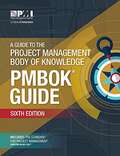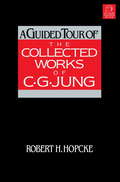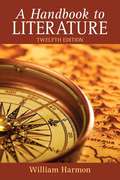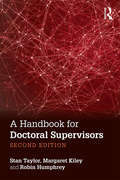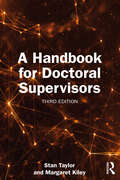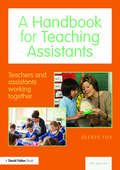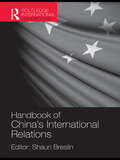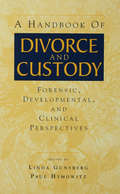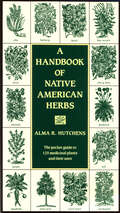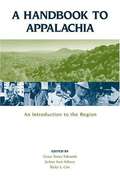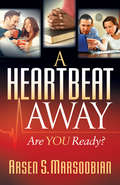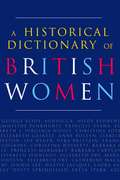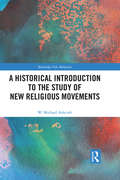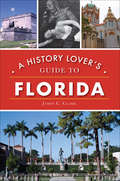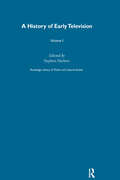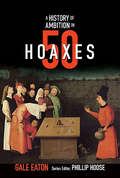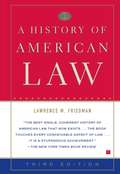- Table View
- List View
A Guide to the Project Management Body of Knowledge
by Project Management InstituteThe PMBOK(R) Guide - Sixth Edition - PMI's flagship publication has been updated to reflect the latest good practices in project management. New to the Sixth Edition, each knowledge area will contain a section entitled Approaches for Agile, Iterative and Adaptive Environments, describing how these practices integrate in project settings. It will also contain more emphasis on strategic and business knowledge-including discussion of project management business documents-and information on the PMI Talent Triangle(TM) and the essential skills for success in today's market.
A Guided Tour of the Collected Works of C. G. Jung
by Robert H. HopckeThe writings of C. G. Jung himself are the best place to read about all his main ideas--but where to start, when Jung's Collected Works run to more than eighteen volumes? Robert H. Hopcke's guide to Jung's voluminous writings shows exactly the best place to begin for getting a handle on each of Jung's key concepts and ideas--from archetypal symbols to analytical psychology to UFOs. Each chapter explains one of Jung's principal concerns, then directs the reader where to read about it in depth in the Collected Works. Each chapter includes a list of secondary sources to approach for further study--which the author has updated for this edition to include books published in the ten years since the Guided Tour's first appearance.
A Handbook To Literature (12th Edition)
by William HarmonThe definitive reference on literature in English, this handbook provides an alphabetical listing of more than 2,000 important terms and facts in literature, linguistics, rhetoric, criticism, printing, bookselling, and information technology.
A Handbook for Doctoral Supervisors
by Stan Taylor Margaret Kiley Robin HumphreyAcross the globe, doctoral education is in the throes of change. Diversification, regulation and proliferation are just a few of the developments that pose major challenges for those supervising doctoral candidates. The second edition of A Handbook for Doctoral Supervisors has been fully updated to assist doctoral supervi
A Handbook for Doctoral Supervisors
by Stan Taylor Margaret KileyBased on the latest research and covering key recent developments in supervisory practice, the third edition of A Handbook for Doctoral Supervisors is designed to support new and established supervisors in reviewing how they may make their supervision practice more effective day to day. This new edition is fully updated and extended to provide guidance on all aspects of the supervisory role, including: Recruitment and selection, including placing greater emphasis on candidate diversity; Establishing and managing research projects, from initial conception through to completion and examination; Relationships with candidates and co-supervisors, and the implementation of an explicit respect agenda in relationships with candidates; Providing personal, professional, and career advice, including monitoring the wellbeing and mental health of doctoral candidates; The implications for supervisors of the rapid adoption of online supervision and examination. With a self-interrogatory style which enables supervisors to reflect upon and, where appropriate, consider how to enhance their practice, this key handbook is a crucial read for those directly involved in doctoral supervision, those who manage supervisors, as well as policy-makers, administrators, and scholars within the field of doctoral education.
A Handbook for Teaching Assistants: Teachers and assistants working together
by Glenys FoxThis revised new edition provides essential guidance for all teaching assistants, especially those who are new to the job, and to the teachers working with them. Glenys Fox details the roles and responsibilities of the TA, as well as providing helpful advice on how to best support the teacher, the pupil, the curriculum and the school. This practical handbook will bring experienced TAs up to date on changes to National educational guidance, including changes in the National Curriculum, assessment, and the Special Educational Needs framework. This text enables the assistant and the teacher to work together more effectively in supporting and promoting the progress of children and young people. Written in light of recent research and updates in legislation, this guide will ensure that: teaching assistants know what to expect of colleagues, and vice versa pupils are given the best possible support by teaching assistants who understand their needs teaching assistants and teachers are able to work together effectively to support the learning of all children, especially children who have special educational needs and disabilities any training received is relevant and helpful. A Handbook for Teaching Assistants is an ideal textbook for training, as well as a useful classroom handbook for teaching assistants working in early years, primary and secondary settings.
A Handbook for the Prospective Guide Dog Handler
by Guide Dog Users Inc.A handbook full of information for those considering getting a guide dog.
A Handbook of Abbreviations
by Portrait AdvertisingGiven in this book are some of the commonly used abbreviations with particular reference to those used in the Indian context.
A Handbook of Biological Investigation (Seventh Edition)
by Harrison W. Ambrose Katharine Peckham Ambrose Douglas J. Emlen Kerry L. BrightThis book is written as a reference aid to be used by biology students at any time they are first exposed to the scientific method and to original research. It guides the beginner through elementary experimental design, data collection and analysis, and the subsequent writing of a scientific report. In addition, it provides an introduction to the literature of biology and a basic search strategy for finding relevant, published information in a library.
A Handbook of China's International Relations (Routledge International Handbooks Ser.)
by Shaun BreslinThis Handbook, comprising around twenty-five chapters provided by numerous experts in the field, will prove invaluable to students of international affairs, academics, researchers, businesspeople and policy analysts. Chapters will give up-do-date and unbiased information on the current state of Chinese international relations in historical perspective.
A Handbook of Divorce and Custody: Forensic, Developmental, and Clinical Perspectives
by Linda Gunsberg Paul HymowitzThe Handbook of Divorce and Custody brings together mental health professionals and forensic specialists dedicated to working in the legal arena with families in crisis. Section I provides the individual perspectives of experienced clinicians, all of whom share a psychodynamic and developmental purview, and supplements their accounts with the viewpoints of a lawyer and a judge. Section II examines parental psychopathology, which is often at the root of family conflict and turmoil. Section III deals with the nature and extent of the state's potential involvement with the family, from ensuring parents' rights to raise their children to identifying those circumstances that justify the termination of parental rights. The remaining three sections follow the progressive issues engaged by divorcing families as they work their way through the legal system: forensic evaluation, post-divorce legal arrangements, and the emotional aftermath of divorce, including indications for various types of therapeutic intervention. Through the Handbook, contributors pay special attention to a set of core issues that underlie - and complicate - the evaluations, recommendations, and judicial determinations that enter into the divorce/custody process. Specifically, they focus on the inherent conflict between the family's right to privacy and the state's commitment to the best interest of children; the increasingly uncertain question of what constitutes a family and who has the right to legal standing; the problematic role of fathers in the lives of their children; the nature of the evaluation process and the role of the forensic expert in a "good enough" evaluation; the important differences between the role of therapist and the role of evaluator; and, finally, the impact of divorce itself on the lives of today's children.
A Handbook of Idioms and Phrases
by Seasons PublishingThis book is a reference pamphlet for the use of students of English as a second language. Lists commonly used idioms and expressions, mostly American English.
A Handbook of Native American Herbs: The Pocket Guide to 125 Medicinal Plants and Their Uses
by Alma R. HutchensThis authoritative guide--based on the author's classic reference work, Indian Herbalogy of North America--is a portable illustrated companion for the professional and amateur herbalist alike. It provides detailed descriptions of 125 of the most useful medicinal plants commonly found in North America, along with directions for a range of uses, remedies for common ailments, and notes on the herbal traditions of other lands. Entries include staples of folk medicine such as echinacea and slippery elm as well as common kitchen herbs--such as parsley, thyme, and pepper--whose tonic and healing properties are less widely known.
A Handbook of Proverbs
by Portrait AdvertisingA proverb is a simple and concrete saying popularly known and repeated, which expresses a truth, based on common sense or practical experience of humanity. Proverbs abound in English. This book helps you to become familiar with their usage.
A Handbook of Quotations
by Portrait AdvertisingA quotation should inspire. It should also make the reader think and use it. In this book are selections of immortal words of some of the greatest thinkers, politicians, philosophers, etc., and other eminent personalities from all around the world.
A Handbook to Appalachia: An Introduction to the Region
by Grace Tomey Edwards Noann Aust Asbury Ricky L. CoxReference work introducing various aspects of the Appalachian region including geography, history, the arts, etc.
A Happy Move: Everything You Need to Know Before and After the Boxes Are Packed
by Devra Jacobs Brit EldersThis interactive how-to book can help relieve the anxiety and stress of relocation while giving people who are moving great tips on how to organize, control, and enjoy the experience.Moving. It&’s a major life change. It doesn&’t matter if it&’s across town or across the country, the event of moving creates a mixed emotional mindset. From packing up all your possessions to renting and driving a moving truck to reconnecting your services, there are so many things to take care of in a move that the whole process can be daunting. Sprinkled with first-hand experiences and tips, A Happy Move is your owner&’s guide for a seamless, practical, stress-free move. This book provides plenty of recommendations and resources, with inside knowledge from U-Haul® and 1-800-PACK-RAT. The convenient spiral-bound book includes various lists that help you check off the items required before, during, and after a move to make the process easier, more cost-effective, and more fulfilling. It&’s a tool for anyone considering a location change, whether it&’s for work, school, military service, closeness to family and friends, or just a change of scenery. No matter the distance or final destination, if you&’re a renter or homeowner, you, too, can follow this step-by-step process and experience A Happy Move.
A Heartbeat Away: Are YOU Ready?
by Arsen S. MarsoobianThe probability of death is 100% and people need to be ready for that inevitability. The how and when is not a choice for most people and the consequences of the actions they take before that happens are already determined, yet the subject of death (particularly one’s own mortality) is avoided by almost everyone. A Heartbeat Away reveals the importance of being ready and provides the facts of actions’ consequences through true, personal stories, professional experiences and additional resources, even from centuries ago. Addressing three specific areas, Spiritual, Relationships, and Finances, Arsen Marsoobian (or “Papa SOOB”) offers suggestions and a blueprint for readers to ask themselves important, life-changing questions. A Heartbeat Away moves readers to stop and reflect on their lives and the people they love in order to prevent regrets when the day comes that they don’t make it back to their comfy bed and leave this world behind.
A Historical Dictionary of British Women
by Cathy HartleyThis reference book, containing the biographies of more than 1,100 notable British women from Boudicca to Barbara Castle, is an absorbing record of female achievement spanning some 2,000 years of British life.Most of the lives included are those of women whose work took them in some way before the public and who therefore played a direct and important role in broadening the horizons of women. Also included are women who influenced events in a more indirect way: the wives of kings and politicians, mistresses, ladies in waiting and society hostesses.Originally published as The Europa Biographical Dictionary of British Women, this newly re-worked edition includes key figures who have died in the last 20 years, such as The Queen Mother, Baroness Ryder of Warsaw, Elizabeth Jennings and Christina Foyle.
A Historical Introduction to the Study of New Religious Movements (Routledge New Religions)
by W. Michael AshcraftThe American public’s perception of New Religious Movements (NRMs) as fundamentally harmful cults stems from the "anticult" movement of the 1970s, which gave a sometimes hysterical and often distorted image of NRMs to the media. At the same time, academics pioneered a new field, studying these same NRMs from sociological and historical perspectives. They offered an interpretation that ran counter to that of the anticult movement. For these scholars in the new field of NRM studies, NRMs were legitimate religions deserving of those freedoms granted to established religions. Those scholars in NRM studies continued to evolve methods and theories to study NRMs. This book tells their story. Each chapter begins with a biography of a key person involved in studying NRMs. The narrative unfolds chronologically, beginning with late nineteenth- and early-twentieth century perceptions of religions alternative to the mainstream. Then the focus shifts to those early efforts, in the 1960s and 1970s, to comprehend the growing phenomena of cults or NRMs using the tools of academic disciplines. The book’s midpoint is a chapter that looks closely at the scholarship of the anticult movement, and from there moves forward in time to the present, highlighting themes in the study of NRMs like violence, gender, and reflexive ethnography. No other book has used the scholars of NRMs as the focus for a study in this way. The material in this volume is, therefore, a fascinating viewpoint from which to explore the origins of this vibrant academic community, as well as analyse the practice of Religious Studies more generally.
A Historical and Legal Comparison between Tianxia Wei Gong and Quod Omnes Tangit (Ius Gentium: Comparative Perspectives on Law and Justice #110)
by Yifan ShangThis book explores the historical and legal importance of two principles, Quod Omnes Tangit, and Tianxia Wei Gong, which have played significant roles in European and Chinese political and legal history. While Quod Omnes Tangit has been thoroughly researched, Tianxia Wei Gong has not been systematically examined. This thesis fills this void and connects these two principles for the first time. Quod Omnes Tangit was initially introduced in Justinian's Codex Civil, while Tianxia Wei Gong originated from Liji, one of the books in a key series of works by Confucius. Liji is comparable to the Thora in the Old Testament and is considered as important as law in Chinese legal history. Both principles have undergone comparable developmental processes, with scholars contributing to their reinterpretation. This book thoroughly examines the interpretations of individual scholars, with particular attention given to Liang Qichao, who is the only one to have mentioned both Tianxia Wei Gong and Quod Omnes Tangit. The book also provides an explanation for the original discrepancies in their concepts, particularly their methodologies in distributing and legitimizing rights. This research will be of interest to legal philosophers and historians in both the Western and Eastern worlds, legal practitioners and policymakers, and researchers seeking to explain current events and explore fundamental differences between the East and West.
A History Lover's Guide to Florida (History & Guide)
by James C. ClarkExplorers and pirates, hurricanes and shipwrecks, movie stars and presidents—a journey through Florida’s history and a guide to the places it happened.More than any other state (except Nevada), Florida is a state of transplants—where a quarter of the population comes from outside the US, and a third comes from other states. Thanks to its famous beaches and tourist attractions, it’s often thought of as more a destination than a home…even for those who live there. In spite of this—or perhaps because of it—the Sunshine State has one of the richest histories in the nation. Decades before the Pilgrims, the Spanish celebrated Thanksgiving in Florida. Centuries before the first St. Patrick’s Day Parade in New York, the holiday was celebrated in St. Augustine, where urban renewal was underway when Jamestown settlers arrived. In this lively guide, James Clark offers a lifetime of places to explore and facts to fascinate, tracing the state’s long and colorful history from Pensacola to the Florida Keys. You’ll find photos, illustrations, and detailed lists of 10 forts, 10 wars, 5 flags that flew over Florida, 40 historic landmarks, 50 museums, and much more.
A History Of Early Television Vol 1
by Stephen HerbertIn the 21st Century, broadcast television is an established part of the lives of many millions of people all over the world, bringing information and entertainment directly into our homes. The pieces in this volume date from 1879 to 1934 and consist of a selection of books, articles and news items relating to the first developmental period of television, before it became the ubiquitous medium that we know today. The selection is English language material only.
A History of Ambition in 50 Hoaxes (History in #50)
by Phillip Hoose Gale EatonWhat do the Trojan Horse, Piltdown Man, Keely Motor Company, and Ponzi Scheme have in common? They were all famous hoaxes, carefully designed and bolstered with false evidence. The con artists in this book pursued a variety of ambitions--making money, winning wars, mocking authority, finding fame, trading an ordinary life for a glamorous one--but they all chose the lowest, fastest road to get there. Every hoax is a curtain, and behind it is a deceiver operating levers and smoke machines to make us see what is not there and miss what is. As P.T. Barnum knew, you can short-circuit critical thinking in any century by telling people what they want to hear. Most scams operate on a personal scale, but some have shaped the balance of world power, inspired explorers to sail uncharted seas, derailed scientific progress, or caused terrible massacres. A HISTORY OF AMBITION IN 50 HOAXES guides us through a rogue's gallery of hustlers, liars, swindlers, imposters, scammers, pretenders, and cheats. In Gale Eaton's wide-ranging synthesis, the history of deception is a colorful tour, with surprising insights behind every curtain.
A History of American Law: Third Edition
by Lawrence M. FriedmanIn this brilliant and immensely readable book, Lawrence M. Friedman tells the whole fascinating story of American law from its beginnings in the colonies to the present day. By showing how close the life of the law is to the economic and political life of the country, he makes a complex subject understandable and engrossing. A History of American Law presents the achievements and failures of the American legal system in the context of America's commercial and working world, family practices, and attitudes toward property, government, crime, and justice. Now completely revised and updated, this groundbreaking work incorporates new material regarding slavery, criminal justice, and twentieth-century law. For laymen and students alike, this remains the only comprehensive authoritative history of American law.
